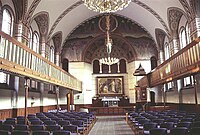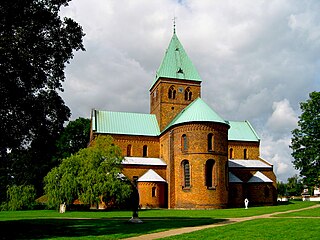
St. Bendt's Church is a church in Ringsted, Denmark, which was originally part of a Benedictine monastery that burnt down in the 18th century. Built in the Romanesque style, it is the oldest brick church in Scandinavia, dating back to about 1170 when it replaced a travertine church from about 1080. It is considered to be one of Denmark's architecturally finest churches. Furthermore, it is of special historical interest as it is the first Royal church in Denmark and it houses the tombs of many of Denmark's earlier monarchs and noblemen.

Østerbrogade is the principal shopping street and thoroughfare in the Østerbro district of Copenhagen, Denmark. It extends from Lille Triangel at the north-eastern tip of The Lakes, passes Trianglen, and continues to Svanemøllen station from where it becomes Strandvejen.
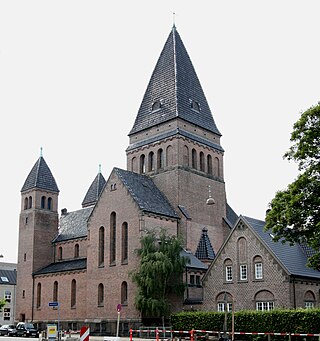
Isaiah Church is a Lutheran church in the Østerbro district of Copenhagen, Denmark.

Christ Church is a Church of Denmark parish church situated on Enghave Plads in the Vesterbro district of Copenhagen, Denmark. It was designed by Valdemar Koch, who also built several other churches in Copenhagen around that time. Completed in 1900, it was the first new church to be opened in the fast-growing neighbourhood to relieve the pressure on St. Mathew's. Its style is inspired by Italian Romanesque church architecture.

Otto Valdemar Koch was a Danish architect and local politician. He designed a number of churches in Copenhagen.

St. Luke's Church is a Church of Denmark church located in the Frederiksberg district of Copenhagen, Denmark. Completed in 1897 to the design of Valdemar Koch, who also built several other churches in Copenhagen around that time, it is the second oldest church in Frederiksberg.
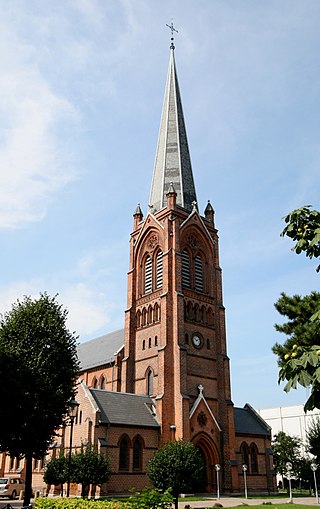
St. James's Church in the Østerbro district of Copenhagen, Denmark, was the first church to be built in the district. It was designed by Ludvig Fenger in a Neo-Gothic style and built between 1876 and 1878.

Ny Kirke is a 12th-century round church located in the village of Nyker some 7 km from Rønne on the Danish island of Bornholm. Built in the Romanesque style with two storeys, it contains frescos from various periods and a pulpit with 17th century-panels.

Aastrup Church, located on the top of a steep hill in the village of Aastrup, 6 kilometres (3.7 mi) southwest of Stubbekøbing on the Danish island of Falster, dates from c. 1200. Built in the Late Romanesque style, it has frescos from the 13th and 15th centuries.

Torkilstrup Church is located in the village of Torkilstrup some 7 km (4 mi) southeast of Nørre Alslev, on the Danish island of Falster. It is built of hewn fieldstone rather than brick, indicating it is one of the oldest churches on the island from before 1160.

Stubbekøbing Church is located in Stubbekøbing some 18 km (11 mi) northeast of Nørre Alslev on the Danish island of Falster. The basilical nave was built of limestone in the Late Romanesque period. Choir and tower are of brick, the choir built in Early Gothic style, tower and the northern chapels in the 15th century in Late Gothic style. In addition to its Renaissance altarpiece and pulpit, it has a variety of old frescos and wall decorations (1300–1500).

Undløse Church is located in the village of Undløse some 17 km (11 mi) southwest of Holbæk in northern Zealand, Denmark. The original part of the Romanesque church derives from the late 12th century. The church is noted for its early 15th-century frescoes and for its elaborate Baroque altarpiece and pulpit, both woodcuts by Abel Schrøder.

Faxe Church is a Danish church located in the Diocese of Roskilde, in Faxe, Region Sjælland on the island of Zealand. It was built at the end of the 15th century on a site where there had originally been a Romanesque church. A number of frescos, probably painted by artists from the Brarup workshop, have been uncovered on the cross vaults, most recently above the organ.

Freerslev Church is located in the Danish Diocese of Roskilde, Faxe Municipality in Region Sjælland on the island of Zealand. Parts of the original Romanesque church subsist today although there have been substantial Gothic additions. Primitive 14th-century frescos have been uncovered in the arch of an old window on the north wall.

Halsted Church stands in the little village of Halsted some 6 km east of Nakskov on the Danish island of Lolland. Dating from the second half of the 12th century, the church has a Romanesque chancel and nave, a large burial chapel from 1636 and a tower from 1877. The church was closely associated with Halsted Priory, which has not survived.

Tillitse Church is a Romanesque building west of the village of Dannemare, some 8 km (5.0 mi) south of Nakskov on the Danish island of Lolland. Built of red brick in the first half of the 13th century, it has an intricately carved auricular altarpiece created by Jørgen Ringnis in 1642. An 11th-century runestone stands outside the church entrance.
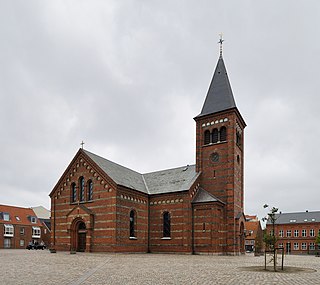
The Church of Our Saviour is a parish church in Esbjerg, Denmark. Completed in 1887 to a design by Axel Møller, it was the first church to be built in the rapidly growing new town.

Tilst Church is a church in Aarhus, Denmark, situated in the suburb Tilst 8 kilometers north-west of Aarhus city center. Tilst Church is from the 1100s, erected as a typical Danish Romanesque village church. Later additions in the 15th century added a Gothic tower and porch. Tilst Church is the only church in Tilst Parish but it is a part of the Tilst-Kasted pastorate which includes Tilst and Kasted Churches. There were 5.163 members of the Church of Denmark living in Tilst Parish on 1 January 2016.

Nazareth Church is a Church of Denmark parish church located at Ryesgade in the Østerbro district of Copenhagen, Denmark.



